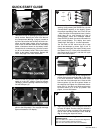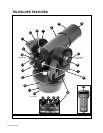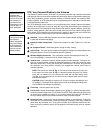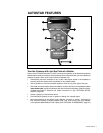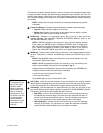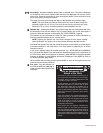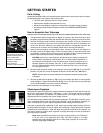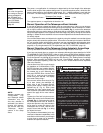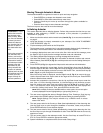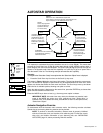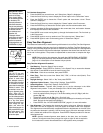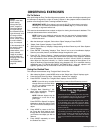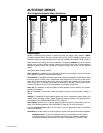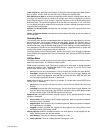
The power, or magnification of a telescope is determined by the focal length of the telescope
and the focal length of the eyepiece being used. To calculate eyepiece power, divide the tele-
scope's focal length by the eyepiece's focal length.
E.g., a 25mm eyepiece is used with the
ETX-60AT. The focal length of the ETX-60AT is 350mm (see "SPECIFICATIONS," page 29).
Telescope Focal Length 350mm
Eyepiece Focal Length 25mm
The eyepiece power, or magnification is therefore 14x.
Manual Operation of the Telescope without Autostar
If you wish to observe a distant land object, such as a mountain top or a bird, you can observe
by merely pointing the telescope and looking through the eyepiece. Set the telescope on a table
top or tripod, loosen the horizontal and vertical locks (
6 and 9, Fig. 1), and turn the telescope
towards the object you wish to observe. Sight along the top of the tube until you find the object.
When the object appears in the eyepiece, focus the image using the by turning the focus knob
(
8, Fig. 1). Rotate the knob clockwise to focus on distant objects and counterclockwise to focus
on nearby objects.
You can also observe stars and objects in the night sky using this method, but note that objects
begin to slowly drift across the eyepiece field. This motion is caused by the rotation of the Earth.
As you become familiar with Autostar operation, you can counteract the drift using the auto-
matic tracking feature in the Setup menu (see "TO TRACK AN OBJECT AUTOMATICALLY,"
page 20), or by using Autostar's GO TO capabilities (see "GO TO SATURN," page 15).
Manual Operation of the Telescope Using Autostar's Arrow Keys
You may also observe land and astronomical objects using Autostar's Arrow keys.
If you have not already done so, prepare your telescope following the steps described in "HOW
TO ASSEMBLE YOUR TELESCOPE," page 10. Next, flip the On/Off Switch (
10, Fig. 1) on the
computer control panel to the ON position. The copyright message lights on Autostar’s display.
Press the Speed/? key (
8, Fig. 3) to accept the Sun warning. The "Getting Started" message
displays. Keep pressing the ENTER key (A) until "Country/State" appears on the display.
(Ignore the prompts requesting "Date" and "Time" for now – these functions will be explained
later in the manual).
Use the Scroll keys (D) to cycle through
the database of countries/states. Press
ENTER (A) when your location displays.
Next, use the Scroll keys (D) to scroll to
the nearest city to your observing site
and press ENTER. Next, use the Scroll
keys (D) to scroll to your telescope
model and press ENTER. The display
then reads "Setup: Align."
You can now use the Arrow keys (5, Fig.
3) to slew (move) the telescope up,
down, right, or left. To change the tele-
scope’s slew speed, briefly press the
Speed/? key (8, Fig. 3). Each press
decreases the slew speed down one
level, and then cycles back to the fastest
speed. See page 22 for more informa-
tion.
Tighten (to a "firm feel" only, do not over-
tighten) the vertical and horizontal locks
(
6 and 9, Fig. 1). Sight along the side of
the telescope’s main tube to locate an
object and practice using the Autostar’s
Arrow keys to center the object in the
telescope’s field of view. Use the tele-
scope’s focus knob (
8, Fig. 1) to bring
the object into focus.
This procedure demonstrates just a very
small part of Autostar's capabilities. In the
next section of this manual, you will begin
to learn how to make use of Autostar's
extensive and powerful features.
Getting Started 11
TIPS
FOR BEGINNERS
Too Much Power?
Can you ever have too much power? If the type of
power you’re referring to is eyepiece magnification,
yes, you can! The most common mistake of the
beginning observer is to “overpower” his or her tel-
escope by using high magnifications which the tele-
scope’s aperture and atmospheric conditions can
not reasonably support. Keep in mind that a small-
er, but bright and well-resolved image is far superi-
or to one that is larger, but dim and poorly resolved
(see below). Powers above 110X should be
employed only under the steadiest atmospheric
conditions.
Autostar can calculate the best eyepiece for you to
use. Try out the “Eyepiece Calc” feature in the
Utilities menu.
Most observers should have three or four addition-
al eyepieces to achieve the full range of reasonable
magnifications possible with the ETX telescopes.
See “OPTIONAL ACCESSORIES,” page 25.
Fig. 7a & b: Jupiter; example of too much magnification.
NOTE:
For a list of magnifica-
tion ratings of the eye-
pieces available for
the ETX-60AT and
ETX-70AT telescopes,
see "OPTIONAL
ACCESSORIES,"
page 25.
Fig. 6: Autostar's Arrow
keys.
Eyepiece Power =
= 14X
=
NOTE:
Autostar requests the
Country/State, City,
and Telescope Model
information only the
first time Autostar is
activated. If you wish to
change this informa-
tion, use the "Site" and
"Telescope Model"
options in the Setup
menu.



